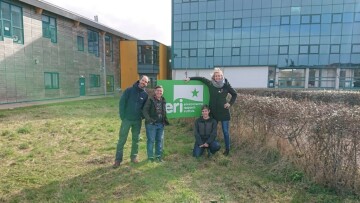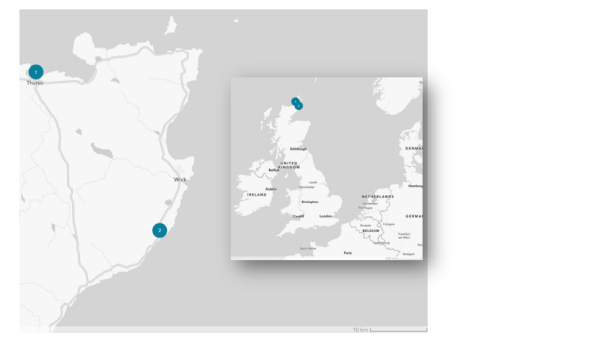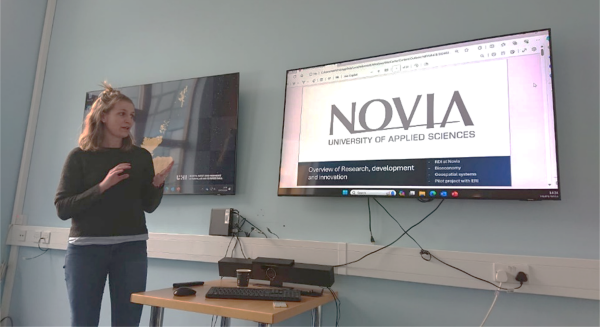Sharing knowledge about renewable energy infrastructure impacts on biodiversity in Thurso

End of March, I was visiting the Environmental Research Institute (ERI) in Thurso, Northern Scotland for a week, with my collaborator Fábio Balotari-Chiebáo. This visit was conducted in the framework of a pilot project funded by The Scottish Education Exchange Programme Test and Learn Project between University of the Highlands and Islands (UHI) and Novia. Part of this pilot project was on-site visits to foster closer collaboration opportunities to share our common knowledge on Cumulative Impacts of Renewable energy and related infrastructure on biodiversity (Collaboration, Understanding and Support) – hence the acronym CIRCUS.

During my visit in Thurso (1 on the map), I notably got the opportunity to discover and get acquainted with the bioeconomy of the beautiful and remote county of Caithness. One of my host, Barbara Bremner, showed me around the breathtaking landscapes of the county and got me deep into storytelling about its questionable integrated management. Indeed, Caithness is notably covered with one of the largest peatland blanket bogs of Europe, the Flow Country. The site is protected by special acts but still prone to invasive human bioeconomy activities such as forestry involving introduced species and onshore wind turbines developments (largely discussed during the conference I assisted). The same statement goes for the fragile cliffs of the protected east coast of Moray Firth, and of the Pentland Firth situated at the northern part of the county. Their crucial values for nature conservation (SAC – special area of conservation) and cultural heritage are being tarnished by offshore energy infrastructures (windfarms, tide turbines and abandonned oil rigs – 2 on the map). It definitely resonates with new developments that are being planned in Finland and makes you question the fairness of our energy transition and the readiness of all stakeholders to conduct a true shift.

Aurélie giving a presentation about Novia
I also got introduced by two of my other hosts, Natalie Isaksson and Elisabeth Masden, to the amazing educational facilities that UHI hold in Caithness (Ormlie road, Castle Street and Rural Studies Centre). I was showed well populated labs with advanced instruments and gears displaying dynamic research and educational programmes. I got to meet research fellows and teachers working with common themes shared with Novia like forestry, game management, environmental planning, pollution, energy, water quality. Presenting my own and Novia’s work, it was easy to notice how similar our two institutions are, and how partnerships between us is self-evident. We also recognized our obvious matching skill sets and got immediately to work on proposal plan related to our pilot theme of cumulative impacts of renewable energy infrastructure on biodiversity, this truly was an exciting time.
At the end of my trip, we identified so many opportunities for both our institutions in terms of research and education that it was already agreed that the pilot project was a success in itself, with much more to pursue in the coming months.
On a personal note, I just enjoyed being called “love” by the train attendant during my 8-hour train trip from Thurso back to Edinburg when she handed me my coffee; or appreciated that they held the connecting train to Thurso on my way “up” - this truly shows that warm feeling that people in Northern Scotland showcase.
Aurélie Noel, team leader for the expertise of geospatial systems at the faculty of bioeconomy and project leader at Novia University of Applied Sciences.
Main picture: Fábio Balotari-Chiebáo, Natalie Isaksson, Elizabeth Masden, and Aurélie Noel.

The Travel report "Sharing knowledge about renewable energy infrastructure impacts on biodiversity in Thurso" has been reviewed by Novia's editorial board and accepted for publication on 17.5.2024
ISSN: 2670-028X
![]()
Reseskildringen har publicerats i Novias publikationsserie RS: Reseskildringar. Inläggen har godkänts av Novias redaktionsråd.
Novia Publikation och produktion, serie RS: Reseskildring, ISSN: 2670-028X
Vi följer CC_BY 4.0 om inget annat nämns.